December 18, 2015
Air Date: December 18, 2015
FULL SHOW
SEGMENTS
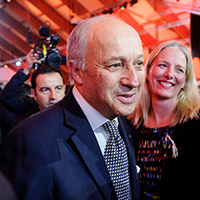
Hope and Concern Sparked By Paris Climate Deal
/ Helen PalmerView the page for this story
In Paris, nearly 200 countries ratified an agreement outlining climate action commitments aimed at restricting global temperature rise to 2 degrees or less. Host Steve Curwood analyzes final remarks from Secretary of State John Kerry on the power of American business, former UNFCCC critic Claudia Salerno of Venezuela’s preamble, and a “technical error” which could have derailed everything. Also, Living on Earth’s Helen Palmer polls delegates from developed and developing nations on the outcome, including Edna Molewa of South Africa, Miguel Arias Canete of the European Union, Paul Oquist Kelley of Nicaragua, Peter Hans Emberson of Fiji. (13:10)
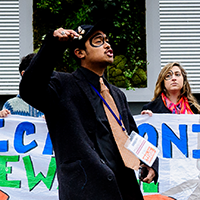
Goodbye Oil, Gas and Coal? The World Faces the Epic Challenge of the Paris Agreement
View the page for this story
With a new climate agreement in place, can its goals be achieved? Mark Hertsgaard, Environment Correspondent for the Nation Magazine tells host Steve Curwood that to keep the global temperature rise “well below 2 degrees Celsius”, we’re going to need to put an end to fossil fuel subsidies and stop drilling for oil and gas and totally decarbonize the global economy. (11:00)
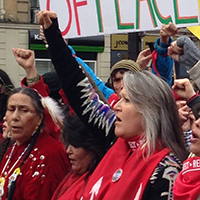
The Climate Movement in the Streets
/ Emmett FitzGeraldView the page for this story
While delegates finalized the language on the Paris Agreement, climate activists gathered in the streets demanding greater efforts to stop fossil fuel expansion and protect the people most vulnerable to the impacts of climate change. Living on Earth’s Emmett Fitzgerald recorded an audio postcard from the protests. (02:00)
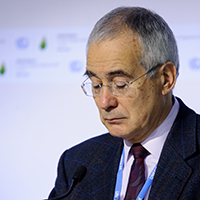
Paris Agreement Opens Door for Green Investment
View the page for this story
Cash flow for sustainable development is essential to make the Paris Agreement reality, yet the accord doesn't include firm financial commitments from developed countries. Lord Nicholas Stern tells Host Steve Curwood how the Agreement will likely mobilize public and private investment to help developing countries. (06:00)
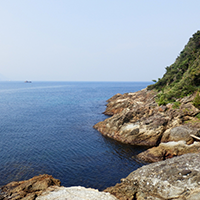
Beyond the Headlines
/ Peter DykstraView the page for this story
In this week’s trip beyond the headlines, Peter Dykstra tells host Steve Curwood about Japan’s resumption of nuclear waste burial under the sea, possibly violating international treaties; how a North Carolina town bans solar energy citing unsubstantiated health and safety reasons; and remembers Harry S. Truman’s creation of the Nevada Proving Grounds, a site for nuclear bomb testing and nuclear waste storage. (04:40)
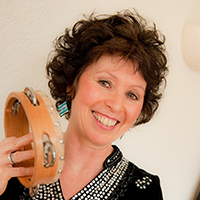
The Wooden Sword / A Story of Peace
View the page for this story
Storyteller Noa Baum collects traditional tales from all over the world and creates original stories. Rooted in Afghan-Jewish traditions, “The Wooden Sword” shows us how faith can help us find happiness, even when we are faced with adversity. (10:45)
Show Credits and Funders
Show Transcript
HOST: Steve Curwood
GUESTS: Peter Hans Emberson, Mark Hertsgaard, Nicholas Stern,
REPORTERS: Emmett FitzGerald, Helen Palmer, Peter Dykstra
[THEME]
CURWOOD: From Public Radio International, this is Living on Earth.
[THEME]
CURWOOD: I'm Steve Curwood. Putting the climate accord into context. First what it means for the low-lying nations.
EMBERSON: We have come to the United Nations process to tell our stories that your lifestyle is affecting mine, and if we are to coexist as one people on this planet, then we need to look after the safety of our brothers and sisters in other distant parts of the world.
CURWOOD: And what we do to make the promises a reality.
HERTSGAARD: It is amazing, it is an inspiring accomplishment that you get 195 countries to collectively pledge to deal with an existential threat to human civilization, and to do so by essentially phasing out fossil fuels, but that's the rhetorical side. Turning this into practice -- that's going to be the trick.
CURWOOD: Those stories and decoding climate cash and more this week, on Living on Earth. Stick around.
[NEWSBREAK MUSIC: Boards of Canada “Zoetrope” from “In a Beautiful Place Out in the Country” (Warp Records 2000)]
ANNOUNCER: Support for Living on Earth comes from United Technologies – innovating to make the world a better, more sustainable place to live.
Hope and Concern Sparked By Paris Climate Deal
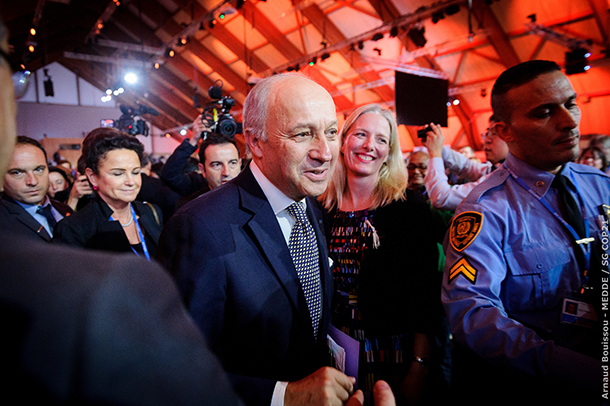
COP21 President Laurent Fabius, following the adoption of the Paris Agreement. (Photo: COP PARIS, Flickr Public Domain)
[THEME]
CURWOOD: From the University of Massachusetts Boston and PRI, this is Living on Earth. I’m Steve Curwood, back with our crew from the climate summit in Paris. Coming up in today’s program, we’ll take a look at where the Paris Agreement might or might not head us in the future. But first, a look back at this historic compact among nearly 200 countries aimed at keeping the world from climate disaster, an agreement that prompted praise and jubilation from its architects.
KERRY: This is a tremendous victory for all of our citizens, not for any one country or any one bloc, but for everyone here who has worked so hard to bring us across the finish line. It's a victory for all the planet and future generations.
CURWOOD: Secretary of State John Kerry had put US credibility on the line to make it happen – and he thinks that business will flourish as a result.
KERRY: We are sending literally a critical message to the global marketplace. Many of us here know that it won't be governments that actually make the decision, or find the products the new technology, the saving grace of this challenge. It will be the genius of the American spirit it will be business unleashed because of 186 nations saying to global business in one loud voice we need to move in this direction. And that will move investment, that will create new greater research and development, and the next great product will come that will change our lives.

Secretary of State John Kerry highlighted the relevance of the Paris Agreement to strengthening American business. (Photo: COP PARIS, Flickr Public Domain)
CURWOOD: And it does seem Paris will be good for the economy, though it remains to be seen just how good it will be for the environment and human progress, as it put no overall cap on global warming emissions, and raised as many questions about equity as it answered.
But this unique moment of near global unity prompted national delegations to speak after the COP21 pact was formally accepted, including Claudia Salerno of Venezuela, an outspoken critic of the UN process during the failed COP15 in Copenhagen.
She played a critical role in writing the non-binding preamble of the Paris Agreement, which declares its moral imperatives.
SALERNO SPEAKING IN SPANISH: (TRANSLATION): ...which I believe is really revolutionary because it welcomes all these social dimensions of climate change, and this will be a direction for the implementation of the agreement. Retaining concepts such as gender equality, the empowerment of women, equity, intergenerational equity… [APPLAUSE] …the rights to health, climate justice, the right to development, Mother Earth, and in particular, human rights. [APPLAUSE]
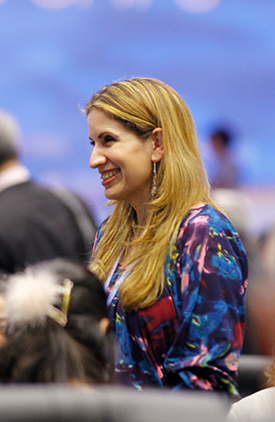
Former UNFCCC critic Claudia Salerno of Venezuela wrote the preamble to the Paris Agreement. (Photo: Arend Kuester, Flickr CC BY-NC 2.0)
CURWOOD: And the climate envoy also earned huge applause when she announced that Venezuela would support the agreement. Achieving this breakthrough in Paris was a high-wire act right to the end, and was nearly sunk by a small word change in a clause about developed countries making economy-wide emissions reductions. A conditional “should” that had been negotiated earlier suddenly became a declarative “shall” – in the last draft. The US delegation said it couldn’t sign on, as the deal would impose a mandate beyond those in original UNFCCC treaty, which was ratified by the Senate back in 1993.
But there is a reason “finesse” is a word rooted in French, and COP21 President and French foreign minister Laurent Fabius found a diplomatic solution: a technical error had been made. He declared the text agreed and gaveled it through. As delegates left the plenary hall they were met by a scrum of reporters including Living on Earth’s Helen Palmer. Hey, Helen what a night!
PALMER: Yeah, all those diplomats, dozens of TV cameras and microphones pointed at them like teeth as all the folks trickled out! But most of the delegates were really beaming though - including the head of the South African team, she’s also the leader of the G77 group of developing nations, it’s the Environment Minister Edna Molewa. She says the 2011 Durban conference laid the foundations for this breakthrough.
MOLEWA: What a long way – a 4 year journey of hard work, dedication, commitment, determination to make it. And here we are, finally we’ve got an agreement, legally binding agreement, that’s actually universal, everybody covered, everybody's happy. Now we're got to get down to work, and we are saying in our statement that even though we have been focused much more on getting this agreement which is post-2020 we have to focus on the pre-2020 action because action doesn't have to start only after 2020, we have got to act now.
CURWOOD: So were they all so glowing and upbeat?
PALMER: Well mostly they were very positive – I mean take the climate change commissioner for the European Union, Miguel Arias Canete.
CANETE: With this Agreement, we're going to stop global warming below the two degrees, or 1.5 – without it, the temperature will be increasing year by year. Now we are in a pathway to 3 degrees. And if we raise the level of ambition over time, we will be able to stop global warming below two degrees, and that's what the world needs, but mainly the poor, because climatic phenomena are more dramatic
for the poor people.
CURWOOD: But what about the delegates from those poorer nations. How did they react?
PALMER: Well, some interesting and ironic comments came from the Nicaraguan climate envoy, Paul Oquist Kelley – who spoke very harshly against the deal after it was agreed. He had some ideas why Europeans and other developed countries might be pleased with the deal.
KELLEY: Oh, I was thinking about the people in Europe, having longer time for vacations, September and October will be nice and warm. You'll get more areas you can grow in in Russia, and in Canada. You'll be able to cross the Arctic on boats, without ice; you'll be able to drill fro more oil in the Arctic, a lot of people are really enthused about that. So while Europe is applauding that, we are boiling, we are being fried, it's not a nice comparison, but I think that we need more empathy for the situation in the Sahel, in Central America, the small island states, and the consequences of climate change further.
CURWOOD: So what about the delegates from the small island countries at risk of seeing their lands literally disappear under rising seas? After all, they helped drive the adoption of the goal to hold global temperature rise to 1.5 degrees. Were they equally unhappy?
PALMER: Well, they did still have some problems, but the ones I spoke to weren’t unhappy. I caught up with the climate change envoy of Fiji. His name’s Peter Hans Emberson.
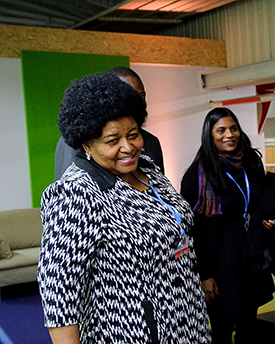
Edna Molewa of South Africa with Laurent Fabius. (Photo: COP PARIS, Flickr Public Domain)
EMBERSON: Yes, I’m very happy with what has transpired here at COP21. The language and some of the particular elements that references the vulnerabilities of Pacific small island states, it has been an enormous victory for small island developing states, especially on the anchoring of loss and damage. I think that is a big achievement for us because there are limits to adaptation, there is only so much communities and nations can do about rising sea levels and for low lying coastal areas, they are particularly vulnerable to coastal inundation, storm surges and eventual sea level rise that will take away large tracts of lands that are low-lying.
PALMER: And that's the case in Fiji, is it?
EMBERSON: Yes, we relocated two communities. It's been an ongoing process of now three years. We've identified 45 communities that will be needing to move after an assessment of 800 communities vulnerable to the impacts of climate change, and we are finding that it's an expensive exercise. It's a traumatic exercise. So, yes, loss and damage here at the Paris COP21 is an affirmation of the work we are already doing underground to prepare people and to identify tracts of land in higher elevation for people to move to.
PALMER: And you have the land?
EMBERSON: We do you have the land. Some communities have the land to move to, but the actual moving of essential infrastructure - hospitals, churches, schools - the actual moving is quite costly so we are having to do it in phases, and some of these plans are 10 to 15 years because of the high expense that's involved.
PALMER: So, yes, loss and damage is in the Agreement, but the question of the money for loss and damage is very unclear.
EMBERSON: The importance of finance will always be something of a work in progress, and we appreciate the establishment of the green climate fund and the bankable projects that have been approved last month in November in Livingston, Zambia. Eight projects have been approved, so this indicates there is some movement, however slow, it is an affirmation that climate financing is going to be made available. Financing is an important means for implementation and I think countries recognize that but we still have to plan and once these plans are in place in the agreement then we could then move to financing, to urge nations with the ability to do so to do the right thing by providing monies for adaptation as well as mitigation to ensure that appropriate technologies to drastically reduce the causes of climate change.
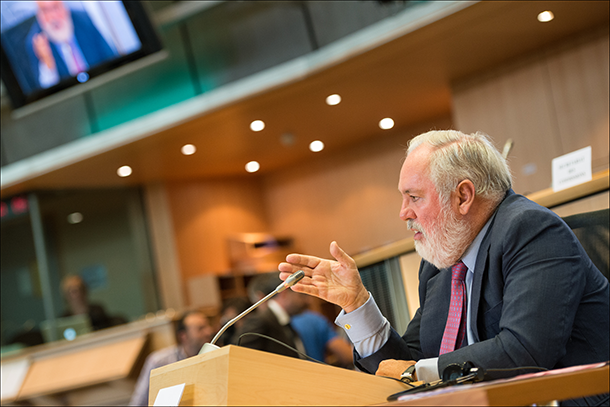
Miguel Arias Canete of the European Union. (Photo: European Parliament, Flickr CC BY-NC-ND 2.0)
PALMER: What is not there that you really wanted to be there and you're disappointed about it?
EMBERSON: Lack of clear articulation on legally binding. That's important to us because not only are we mitigating at the national level far, far beyond our capacity, but we are seeing we have to reduce our dependence on fossil fuel because that is the future. We need to transition into low-carbon dependence. And Fiji has done that, and a lot of small island developing states have done that. All countries should also be doing the same ambitious deep emission cuts, and the lack of a legally binding language, it makes it voluntary, and when it is voluntary, there is no urgency to do something now to put things into policy and to ensure that we are working towards safeguarding the planet's future. If it is voluntary, countries will take their merry time and to the detriment of small island developing states and other vulnerable states.
PALMER: People have been pointing to the power and maybe the moral force of the small developing nations in actually making this agreement happen. What made the small island states and the small developing states and the least developed countries give this big push?
EMBERSON: The Alliance of Small Island States (AOSIS) and small island developing states, we've long recognized that we don't have much by way of resources. We are not Annex I countries that can deliver financing.
PALMER: Annex I are the rich countries?
EMBERSON: The rich countries. That's right. But what we have is the moral imperative to come and make a strong voice here is part of our very existence. We come to the United Nations process to tell our stories, that your lifestyle is affecting mine, and if we have to co-exist as one people on this planet, then we need to look after the safety of our brothers and sisters in another distant parts of the world.
CURWOOD: So that was Fiji’s director for Climate Change, Peter Hans Emberson, speaking with Living on Earth’s Helen Palmer. And, Helen, is there any kind of final comment from the aftermath of the agreement?
PALMER: Well, one of the most charismatic of the NGO leaders is Kumi Naidoo of Greenpeace International. Here’s what he had to say to sum up the message of COP21.
NAIDOO: This is neither the moment for triumphalism nor despair. We cannot afford to be triumphalistic with this deal, when in fact, hundreds of thousands of people have died already from climate impacts because too many powerful governments dragged their feet for 20 years; nor can we be triumphalistic when we know that hundreds of thousands of people are living on the precipice of climate impacts right now. On the other hand, this is not a moment for despair, because the climate movement can take real comfort from the fact that we have won the debate, that the fossil fuel companies now find themselves on the wrong side of history, and that we now need to intensify our efforts to ensure that the emissions targets that are on the table, which takes us to a 3 and a half degrees world, are actually increased in ambition.
CURWOOD: Kumi Naidoo of Greenpeace International. Just ahead - analyzing what comes next, with the Paris Agreement done. Stay tuned to Living on Earth.
Related links:
- How a 'typo' nearly derailed the Paris climate deal
- Paris climate change agreement: the world's greatest diplomatic success
- Kumi Naidoo reacts to conclusion of COP21
- List of Recent Climate Funding Announcements
- Watch final remarks at the Paris Agreement
[CUTAWAY MUSIC: Charlie Haden/Hank Jones, “It’s Me, O Lord,” Steal Away: Spirituals, Hymns and Folks Songs (Verve)]
Goodbye Oil, Gas and Coal? The World Faces the Epic Challenge of the Paris Agreement
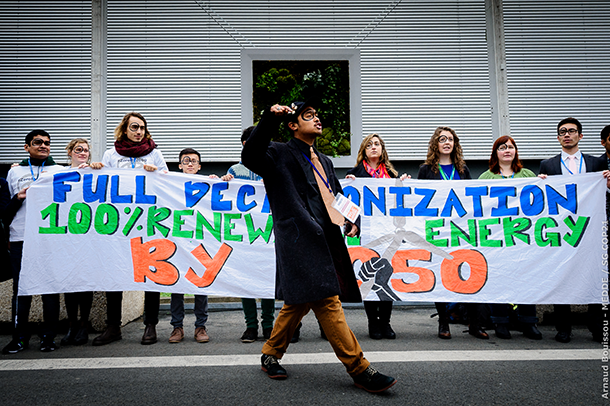
Youth protest inside of the climate conference center (Photo: Emmett FitzGerald)
CURWOOD: It’s Living on Earth, I'm Steve Curwood. For all that it was hard work to craft this agreement, any agreement that could be crafted was by definition a compromise. Many issues that some countries see as core were relegated to the preamble, not in the binding text, and scientists say though the 1.5 degree target is laudable, no concrete steps are required that would make it happen. To put this all in perspective we’re joined by Mark Hertsgaard, the Environment Correspondent for the Nation magazine – who was one of the thousands of journalists at COP21.
HERTSGAARD: The Paris agreement calls for limiting temperature rise to two degrees Celsius above preindustrial levels, 1.5 degrees is the “stretch goal” if you will. Either of those is essentially a death sentence for the fossil fuel industry as currently constituted. In order to hit the two-degree target, or certainly the 1.5-degree target, we've got to as a global civilization phase out fossil fuels more or less starting now. That means no more new oil refineries get built, no more new pipelines get built, no more coal mines get opened etcetera etcetera. And so that's a huge shift. Of course, we'll see if all that happens because the commitments that are included in the Paris agreement are voluntary. That's one of the big questions going forward is will world governments live up to the promises they made in Paris.
CURWOOD: One of the things that's not in the Paris Agreement, Mark, is a price for carbon. There was, of course, a system for pricing carbon in Kyoto, but that's gone. What happens next?

World leaders celebrate the Paris climate agreement (Photo: COP21, public domain)
HERTSGAARD: Putting a price on carbon is the single most powerful policy instrument that exists to fight climate change as long as there is no actual price, you know, you can't blame the marketplace that's going to go where it gets the signals. And so that's I think probably the single biggest question coming out of Paris, is that agreement - which is partly voluntary - is the Paris Agreement strong enough to send a market signal to investors and to businesses around the world. No, it didn't establish a specific price on carbon, but it certainly put the world community on record as moving towards a decarbonized world. The Paris Agreement does say that we will as soon as possible peak global emissions and that we will eliminate or go to carbon neutrality by the second half of the century. That implies a price on carbon, but it does not establish a price on carbon and I think that's going to be one of the big focuses in the months to come, is how do we get a price on carbon and where do we establish it and so forth.
CURWOOD: How fair is this agreement? Some countries, India among them, have said, look there's only so much space to continue emitting carbon and the rich countries rushing ahead, and we don't have a chance to use that pathway to development.
HERTSGAARD: This agreement is not as fair as it should be. It does not treat all emitting countries on the planet equally. People make a big deal about how China is supposedly the biggest global warming polluter, and it is on an annual basis, but that's not what the atmosphere cares about. The atmosphere cares about cumulative emissions over time and there the United States is still comfortably ahead, as is Britain because it was the birthplace of the Industrial Revolution and Europe in general. So that is a huge problem in terms of the fairness of this agreement and there's a second aspect to the fairness, Steve, which is that by saying that we are going to go for a two degree limit and we're only going to provide $100 billion a year in climate aid starting in 2020, aid that has not actually materialized, we are, this agreement essentially condemns literally tens of millions of people in countries like Bangladesh and the Marshall Islands and vast swaths of Africa, countries that are already experiencing horrific climate impacts. This agreement, by not being more ambitious, essentially condemns tens of millions of people to homelessness and poverty and death in the years ahead, and you can say that it was arguably the best agreement that could be achieved and I would argue that, given the political realities in particular here in United States where any agreement that was more specific or generous would've been forced to undergo the gauntlet of US Senate ratification as a treaty, and there the climate deniers and control of the Republican Party would've killed it. So arguably this is the terrible irony of Paris, that it is probably the best agreement that our political situation could achieve and yet it is both on scientific and humanitarian grounds, as Democratic presidential candidate Bernie Sanders says, "It doesn't go nearly far enough."
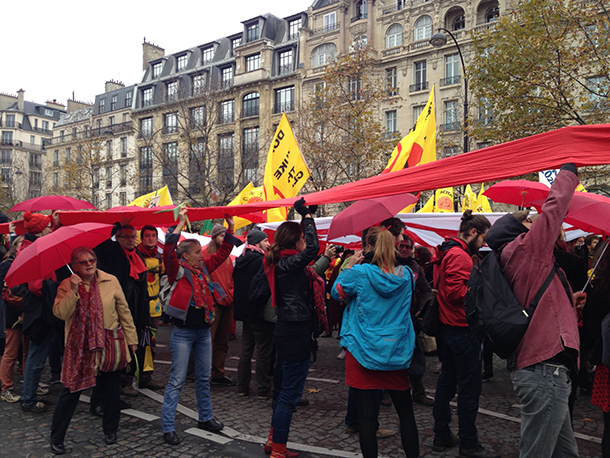
On the final day of the Paris climate conference, protesters stretched red banners through the city to symbolize the red lines in temperature rise that we cannot cross if we want to keep the planet habitable. (Photo: Emmett FitzGerald)
CURWOOD: What does this do for the future of fossil fuel subsidies? There's billions of dollars in fossil fuel subsidies around the world.
HERTSGAARD: Well, there's 40 billion just here in United States; around the world, it's hundreds of billions and it's not all by the way from countries like United States or Saudi Arabia or the petro-states. It's also a country like India where the government for its own political domestic reasons subsidizes the price of heating oil and kerosene so that the poorer classes can afford it. So it's not so obvious how to deal with subsidies in that kind of a domestic political situation. But clearly if you'd take the Paris Agreement seriously and the goal of getting to 1.5 degrees Celsius or least as well below 2 as you can get, you've got to get rid of all the fossil fuel subsidies, you have got to stop building fossil fuel infrastructure the locks you into 30 or 40 years of additional emissions going down the road, and that is the big political challenge here. And it gets to what has been probably the fundamental conflict in international climate diplomacy for the past 25 years, which is the conflict between climate change politics and climate change science. The science is very clear that we need to keep the temperature to at least as well below two degrees as we can. That means that we've got to peak emissions of global warming gases on this planet by 2020. Now that's possible, but we're not going to be able to do it unless we absolutely slam on the brakes of fossil subsidies and new fossil fuel infrastructure here in the United States and around the world.
CURWOOD: As we record this interview, Mark, there's talk on Capitol Hill permitting the export of oil from the US - it hasn't really been allowed for a number of years except in tiny amounts to Canada - in exchange for extending the subsidies for solar and wind. What you make of that?
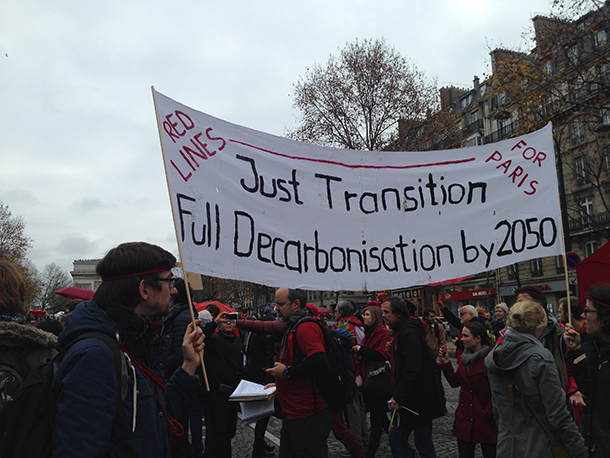
Common demands of protesters in Paris (Photo: Emmett FitzGerald)
HERTSGAARD: This is horse-trading on Capitol Hill as it's been practiced for centuries. You give me this and I'll give you that. And so the Republicans desperately want to lift the oil export ban that's been in place for 40 years and they're offering the Democrats that they will extend the production tax credit for solar and the investment tax credit for solar for another five years. That sounds like almost mature political deal-making in Washington. The problem is the planet, the atmosphere, does not care about what is politically viable in our human institutions. It only cares about physics and chemistry and mathematics and the amount of carbon dioxide and methane that are put up into the atmosphere, and so really again if we are going to be serious about hitting the Paris Agreement targets of keeping temperatures well below two degrees as close to 1.5 as we can, all additional new fossil fuel infrastructure has to stop and that includes exporting more oil around the planet. Also it includes fracking. And by the way, this is kind of a positive side - we do have one trump card up our sleeve here in terms of dealing with these temperature targets, which are so ambitious - which is methane. Methane is a very fast acting, but very potent greenhouse gas. And so if you cut methane emissions, you get an immediate almost payback reducing greenhouse gases in the atmosphere. So this again underlines how the Paris agreement really throws in the stark relief this long-standing conflict between what climate science demands and what climate politics and climate economics wants to offer.
CURWOOD: So the gap between those has been filled so far by a very active civil society. Some would say that the movement that happened in Paris can partially be attributed to the demonstration in New York last year, the divestment movements and so on and so forth, and there where thousands of people in the streets of Paris even at the time when the government there was was not going to permit it. Civil society can make this change. Can it? Will it?
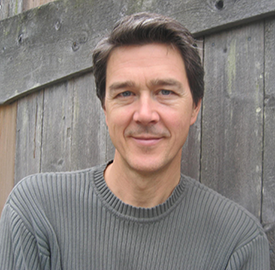
Mark Hertsgaard is Environment Correspondent for the Nation Magazine. (Photo: Francesca Vietor)
HERTSGAARD: Civil society has got to be pushing. That's the only way that these ambitious goals are going to be reached coming out of Paris, but I would include in civil society not just the climate movement which has been hugely important, but also businesses and investors and city and state officials around the world. Much more than national governments, they have been the leaders, those three groups: city officials and state officials, climate movement people, and the big question, business investors. Will they really step up? Will they really accelerate this transition away from fossil fuels at the speed necessary to preserve a livable planet? It's clear after Paris that the world is committed rhetorically to leaving fossil fuels behind, but the Exxon Mobiles and the Saudi Arabias in the world are not to take that lying down. They're going to fight to the end on this, and so I think we see up ahead a "battle royale" as they used to say, between the forces of the status quo, which is still wedded to the 20th century vision of a fossil fuel economy, and the 21st century vision of a green sustainable economy. There's no question that the Paris agreement would not have been talking about 1.5 degrees if you didn't have a very active and growing grassroots climate movement around the world plus a lot of pushing from the least developed countries. And so the big question coming out of Paris is can civil society, the activists, the businesses, the local political leaders and everybody listening to this broadcast, can they push the status quo much faster than it wants to go in order to save the planet for our kids and their kids?
CURWOOD: Mark Hertsgaard is author of "Hot" and an Environmental Correspondent for The Nation. Mark, thanks so much for taking this time with us today.
HERTSGAARD: My pleasure, Steve.
Related links:
- The climate movement is now campaigning to end fossil fuel development on public lands
- About Mark Hertsgaard and his work
- Mark Hertsgaard’s book is called Hot: Living Through the Next 50 Years on Earth
- Read Mark Hertsgaard’s environmental writing in the Nation
The Climate Movement in the Streets
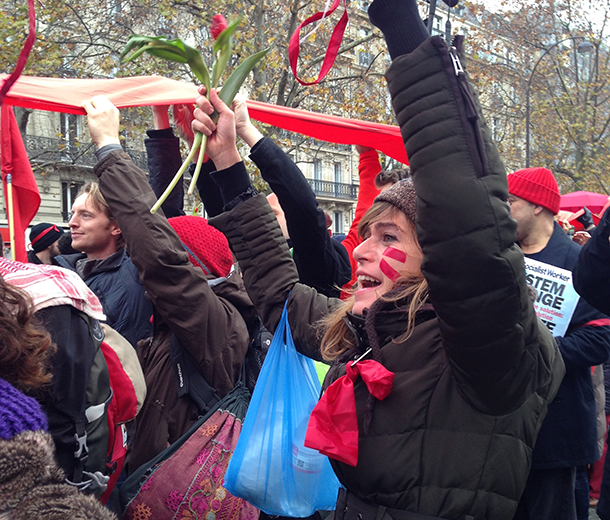
Police lifted the ban on protest, and activists gathered in the streets of Paris as the climate conference wound down. (Photo: Emmett FitzGerald)
CURWOOD: Climate justice activists in Paris, wasted no time in taking their message to the streets, stretching huge red banners, symbolic “red lines” along the avenues of the city, to represent the lines that climate change must not cross and to demand leaders follow though on the agreement and end fossil fuel use. Living on Earth’s Emmett FitzGerald took his microphone to the streets to capture this audio snapshot.
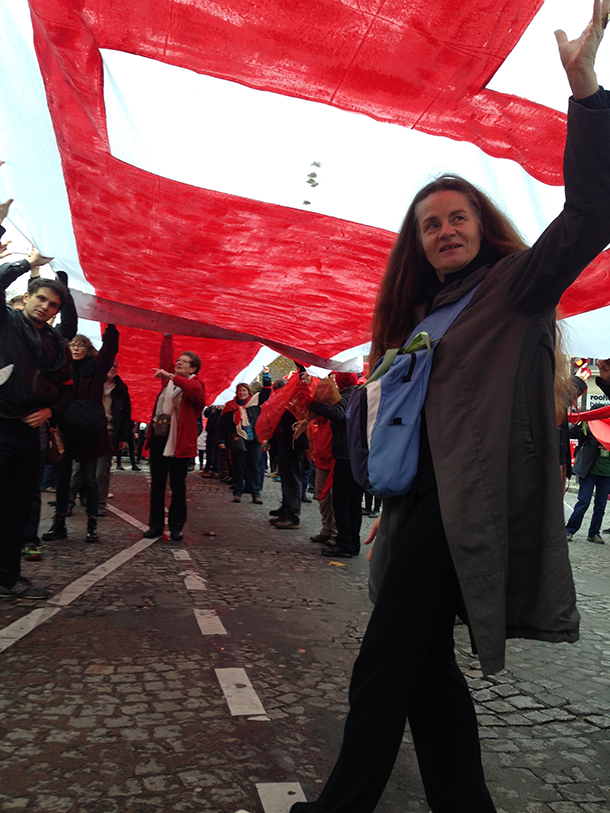
Protesters stretched red banners through the streets to symbolize the red lines that cannot be crossed if we are to keep the planet safe. (Photo: Emmett FitzGerald)
CHANTING: Hey Hey, ho ho, fossil fuels have got to go!
PROTESTER1: My name is Kit Bennett. I am from York in England. One of the reasons I am here is because my government says that it's acting on climate and the Paris climate change conference. That's a lie. They are supporting fracking they are cutting funds to renewable energy. We need to show that we don´t support the actions of the British government and so many of the governments of the world that have only false solutions to the problems of climate change.
PROTESTER2: It´s a worse deal than in Kyoto 18 years ago. That´s why the frontline of climate change isn´t the politicians its people like us, blockading, keeping the fossil fuels in the ground, its fracking in western England, in eastern Europe its brown coal, and that is the way forward.

Indigenous people—often on the front lines of climate impacts—led the march. (Photo: Emmett FitzGerald)
PROTESTER3: My name is Clayton Thomas Mueller and I'm a Cree from Northern Canada, Treaty Six Territory. I'm here to demonstrate that indigenous peoples we are the red line. We are hit first and worst by climate change and its associated drivers like for example Canada's controversial tar sands development in Northern Alberta. So we are here with 35 indigenous representatives from the frontlines of the fight against the fossil fuel regime in North America to stand in solidarity with people from across the planet that are fighting for climate justice.
CHANTING: What do we want? Climate Justice! When do we want it? Now!
Related link:
More photos from the Red Lines protest
Paris Agreement Opens Door for Green Investment
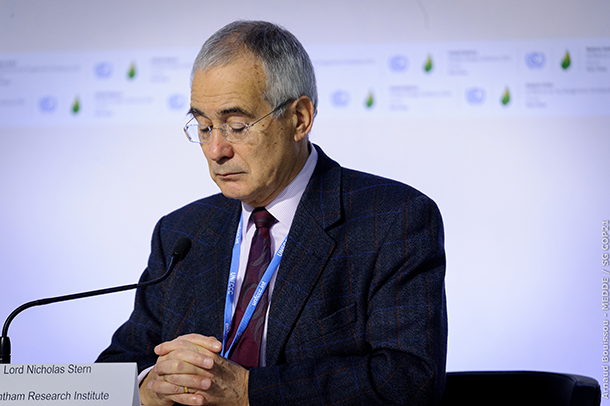
Lord Nicholas Stern at the COP21. (Photo: COP PARIS, Flickr Public Domain)
CURWOOD: A key part of putting the Paris Agreement into effect is finance - mobilizing the cash that developing countries need to build and scale up green infrastructure. The Agreement doesn't include a firm commitment from rich countries to finance these projects. But Lord Nicholas Stern of the London School of Economics who quantified the costs of global warming in the authoritative 2006 Stern Report says that this deal does open a new pathway for investment and prosperity.
STERN: I think it's a very good deal. It says that we have to get not only below two degrees, but do our best to get 1.5 degrees Centigrade as we can. At two degrees, you start to be out on the edge of real tipping points and lots of irreversible effects. So to say that we'll do our best to stay well below two degrees is very important. We didn't know that we'd get that ambition. We didn't know that 1.5 would be mentioned. Second thing that's in there that we could've been sure of, was a commitment to review after five years together with a recognition that the current intentions for 2030 are way too high. If you add up all the intentions you get to levels of emissions about 10 percent higher than now, whereas for a two degree path we ought to be in 2030 something like 20 percent lower. So that ramping up of ambition is right there in the Agreement, and on finance there's a commitment of rich countries to increase their support. Those are just three things, three ways in which I think this is a really good agreement, and I hope that the historians will see this as a historic turning point.
CURWOOD: To what extent does is this agreement help raise the living standards of the poorest among us?
STERN: This is about getting sustainable energy to the more than a billion people in the world who don't have access to electricity. For example, small solar photovoltaic panels with batteries you can charge up mean that people can help their kids studying in the evening by some kind of light, which is not kerosene, which is of course polluting inside the house. It helps people cook in ways which don't poison their lungs. Just in so many ways in health and education, empowering people to look after their own source of energy, this is a story of fostering ambitions of people, enabling them to change their lives for themselves.
CURWOOD: Now in this agreement, we're still talking about $100 billion a year to help the least developed countries. That's the number that was put down some six years ago when Copenhagen fell apart. How do you see this agreement as progress along those lines with the funding to the least developed countries?
STERN: I remember that very well, Steve, because I negotiated that $100 billion working together with Prime Minister Meles Zenawi of Ethiopia who sadly died three years ago and Mike Froman who was then working with Hillary Clinton of the United States. I remember it very well. And it's important, but that's just a small part of the story. The bigger part of the story is enabling people to invest in themselves. And $100 billion by itself doesn't do that, but what it can help do is to create circumstances where cheap finance from a wide variety of sources becomes available. We're now seeing a much bigger story in the trillions of people seeing where the world is going and putting their money to follow that.
CURWOOD: The president of Ethiopia pointed out to me that the interest rates for domestic development there are much higher than the west. If you have to pay 16 percent for money, the capital you could deploy on making payments on that loan is much smaller than what you could do with a 3, 4, 5 percent. How can we bridge the interest rate gap to help development in the least developed countries?
STERN: Steve, that is an absolutely critical point. If you're paying 10 percent real, say, and if you compare that with paying 3 percent real, you're cutting it by more than a factor of three. Now, a lot of the things we're talking about are activities where capital cost is high in relation to the output. Indeed that's the point with renewables. You buy your solar PV panel and then the sun shines and you don't pay for the sunshine. That's a sense in which the capital is much bigger part of your cost. So the cost of capital is extremely important. We can see that governments around the world can borrow close to zero real. So how do you do it? How to close that gap?

Lord Nicholas Stern is a British economist and chair of the Grantham Research Institute on Climate Change and the Environment at the London School of Economics. (Photo: LSE)
CURWOOD: Indeed. How do you do it?
STERN: Well, a lot of these things about risk. So what you try to do for example, is get the multilateral development bank, world bank, Asia development bank, you get them involved in these kinds of deals where can give guarantees or they can take the first loss, and the cost of capital goes right down because people have confidence in that entity, and they also actually reduce the risk itself because if so that risk is about people not behaving very well then that's less like it happen if those banks are involved. I think that this is the area where we are going to start to see the big money flow because we can see this set of opportunities and that's the way in which the cost of capital is going to come down.
CURWOOD: So if you were in charge of everything, what's your first move? What's the most important next step in terms of finance in dealing with the climate crisis?
STERN: I would say two important things: one is to countries around the world now to recognize that this is the sense of direction, so they should be following policies which establish a price for carbon, invest in innovation and then build the financial systems that allow that investment demand to be financed at reasonably low-cost, and through their big financial institutions that manage private money together with the good policies and government we should be in for an era where those tremendous low carbon investment opportunities become investment demand which are financed by a reinvigorated financial system.
CURWOOD: Lord Stern is with the London School of Economics. Thank you so much, Nick, for taking time with us today.
STERN: It's a pleasure talking to you, Steve.
Related links:
- About Nicholas Stern, Center for Climate Change Economics and Policy
- 2006 Stern Review on the Economics of Climate Change
- UNFCCC on climate finance
[MUSIC: Nat King Cole Trio, “I Can’t Give You Anything But Love,” A Musical Contribution by America’s Best for our Armed Forces Overseas: King Cole Trio (V Disc)]
CURWOOD: Coming up...finding the key to happiness. That's just ahead on Living on Earth. Stay tuned.
ANNOUNCER: Funding for Living on Earth comes from United Technologies, a provider to the aerospace and building systems industries worldwide. UTC Building & Industrial Systems provides building technologies and supplies container refrigeration systems that transport and preserve food and medicine with brands such as Otis, Carrier, Chubb, Edwards and Kidde. This is PRI, Public Radio International.
[CUTAWAY MUSIC: Jeff Oster, et al., “Avenue D,” Next (Retso Records)]
Beyond the Headlines
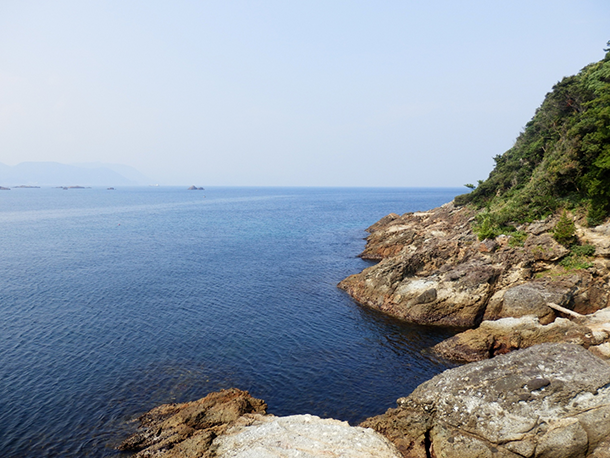
Japan is considering burying spent nuclear fuel in the seabed off the Japanese coast. (Photo: Izu navi, Flickr CC BY 2.0)
CURWOOD: It's Living on Earth, I'm Steve Curwood. Time now to catch up with Peter Dykstra of Environmental Health News, that’s EHN.org and the DailyClimate.org now. We haven’t been checking in with him beyond the headlines while we were in Paris – but he’s on the line now from Conyers, Georgia. Hi there, Peter.
DYKSTRA: Hi Steve, welcome back from Paris. This past week, Japan’s Ministry of Industry said they’re considering a resumption of disposing nuclear waste in the sea – specifically high-level spent fuel to be buried in the seabed off the Japanese coast.
CURWOOD: Uh, excuse me… I mean isn't that something that nations quit doing decades
ago just as they quit whaling, which Japan of course has just restarted? Uh, Peter I’m scratching my head, why do the Japanese want to start dumping nuclear waste into the sea again?
DYKSTRA: Yeah, between the nuclear waste dumping in the ocean and the research whaling, it’s kind of Golden Oldies Week for zombie environmental issues. Japan has tried to find a site to bury the nuclear waste on land for years, but no communities are interested in hosting a nuclear waste dump. The possible ocean nuclear waste dumping may be a violation of two international treaties, The Law of the Sea and another agreement called the London Dumping Convention.
CURWOOD: Well, particularly after Paris, you’d think everyone would like to think that international agreements are taken seriously. What’s next?
DYKSTRA: Well, Steve, while you were off doing your climate thing in Paris, citizens in a small town in the northeast corner of North Carolina were waging a successful battle to keep what they see as a potentially destructive industry out of their town.
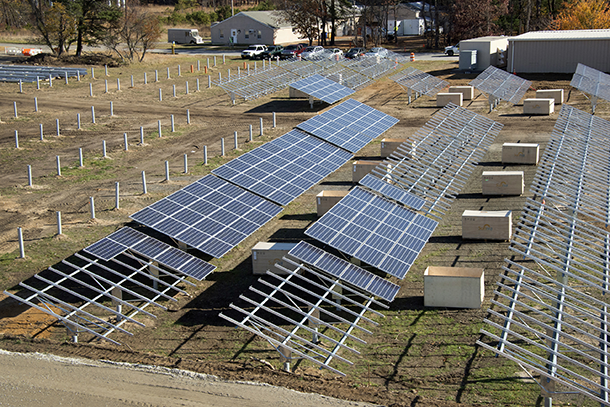
Contrary to the beliefs of the citizens of Woodland, North Carolina, who fought to keep a solar photovoltaic project out of their town, solar farms cannot deprive surrounding areas of sunlight. (Photo: Brookhaven National Laboratory, Flickr CC BY-NC-ND 2.0)
CURWOOD: Well, there’s nothing quite like citizen engagement in defense of their community, so let’s see, in North Carolina what were they doing? Were they fighting those manure pits from hog farms? What about a waste dump or maybe it was a pipeline?
DYKSTRA: No, Steve, they chased away a gang of solar panels. According to the Roanoke-Chowan News Herald there’s great concern in Woodland, North Carolina that solar panels will ruin home values and drive residents away, much like the industrial hog farms have done in some communities to the south of Woodland. Steve, have you ever smelled a solar farm?
CURWOOD: Uh, I don’t think so.
DYKSTRA: Well, maybe you’re spending too much time in those big international meetings, my friend. Anyway, other townspeople testified that solar panels are known to cause cancer, that they suck all of the sunlight out of the immediate vicinity, which could plunge Woodland into darkness, and in absorbing all of the sunlight, the solar panels would kill all the plants by thwarting photosynthesis. And finally, I would like to add that not only am I not making this up, but I checked, and neither is the newspaper that reported it.
CURWOOD: Are you sure? ‘Cause I thought it was pretty funny, actually. Well, what about the truth here? What happened when people pointed out that solar panels aren’t carcinogenic and can’t suck up all the sunlight?
DYKSTRA: Well yeah, the solar company representatives pointed all of that out, but isn’t that what you’d expect them to say? And the resident who described the plant-killing properties of solar panels is actually a retired high school science teacher, so who are you gonna believe? A solar company or a science teacher? The Woodland Town Council believed the science teacher, and a zoning variance that would have permitted the solar farms was voted down, three to one.
CURWOOD: Well, nobody said democracy is pretty - after all, it’s given us what? Jim Crow and laws against teaching evolution. Well, what did you drag out of the history vault this week?
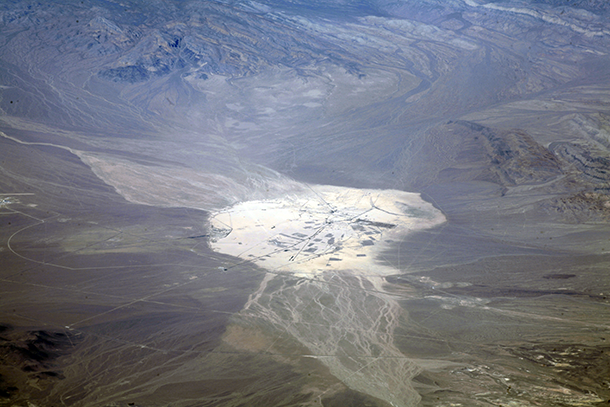
The Nevada Test Site was formerly known as the Nevada Proving Grounds. (Photo: Doc Searls, Flickr CC BY 2.0)
DYKSTRA: Sixty-five years ago this week, President Harry S. Truman created the Nevada Proving Grounds. The U.S. had carried out most of its early nuclear weapons tests in the atmosphere over the Pacific, but in January 1951 the first atomic bomb was dropped over the Nevada desert. Many early tests were in the atmosphere, until the noticeable increase in cancers in downwind residents and soldiers at the site were confirmed, then the program went underground until all testing ended by treaty in 1992. Area 51 of what became know as the Nevada Test Site has an epic folklore as a top secret development area for new weapons systems. Because it was so highly secretive, it became the home of multiple conspiracy theories about aliens.
CURWOOD: Uh, Peter, I’ve got news for you, we don’t cover alien conspiracy theories here!
DYKSTRA: Yeah, I suppose solar panel conspiracy theories are quite enough.
CURWOOD: Youve got it!
DYKSTRA: But one more thing about this historic desert: it’s also home to the Yucca Mountain Repository, the intended home of commercial nuclear waste disposal here in the U.S. or at least it was until the Obama Administration cut off it’s funding a few years ago. Commercial nuclear waste is still stored on-site at most nuclear power plants, even after utilities paid billions into a fund for storing waste at Yucca Mountain.
CURWOOD: Well, I suppose that is better than dumping it into the ocean. Peter Dyskstra is with Environmental Health News, that’s EHN.org, and the DailyClimate.org. Thanks so much Peter, season’s greetings!
DYKSTRA: Well you too Steve, and we’ll talk to you next year.
CURWOOD: And there’s more at our website loe dot org.
Related links:
- Japan to Suggest Possible Nuclear Waste Disposal Sites by Late 2016
- Japan to consider ocean disposal of nuclear waste
- “dumping” in the UN Convention on the Law of the Sea
- About the London Dumping Convention
- US town blocks solar farm over fears it would “suck up all the energy from the Sun”
- More on the Nevada Test Site, formerly the Nevada Proving Grounds
The Wooden Sword / A Story of Peace
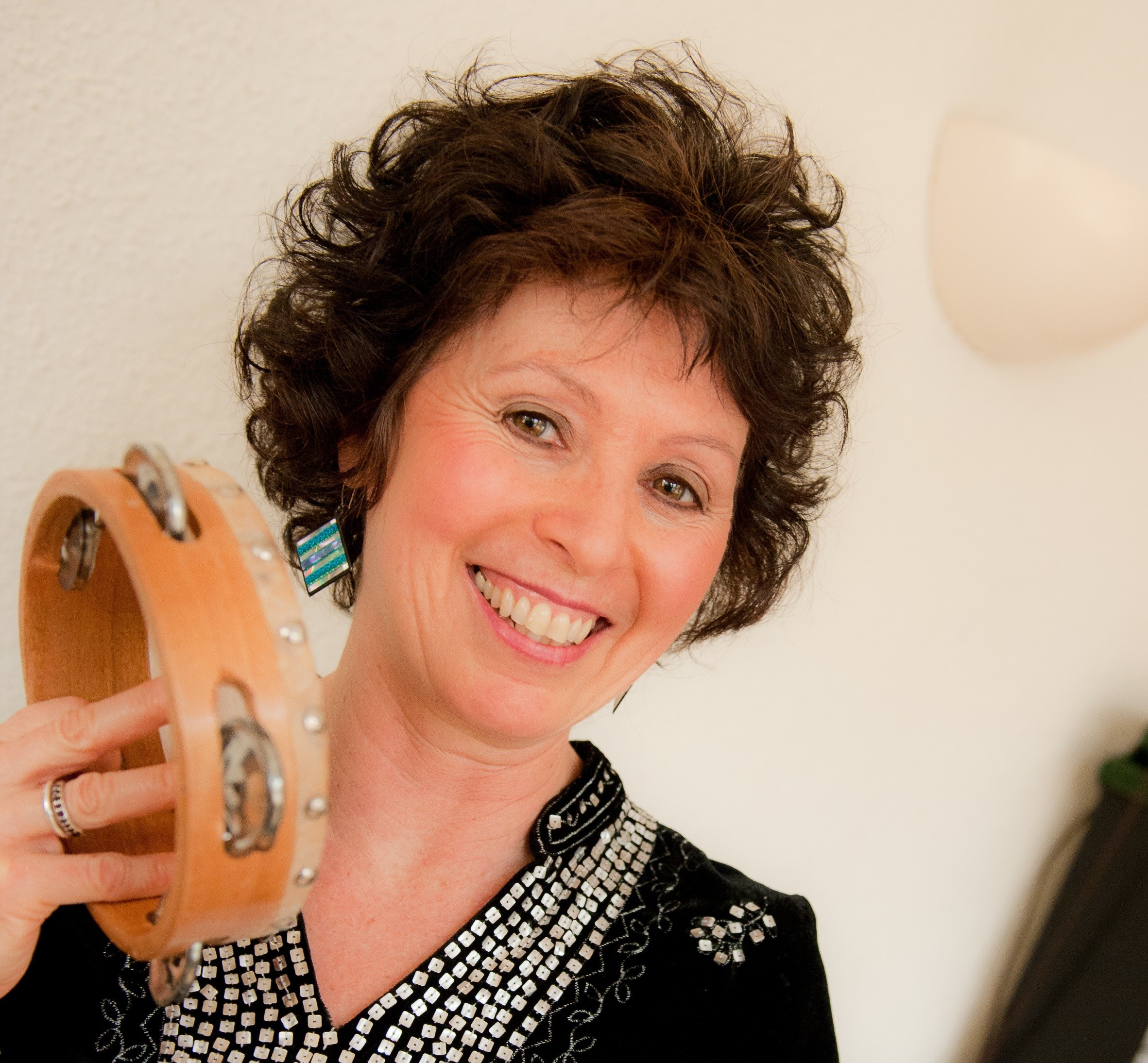
Noa Baum's story, “The Wooden Sword” comes from the Afghani-Jewish tradition. (Photo: Sam Kitner)
CURWOOD: The winter solstice comes just before midnight on Monday, December 21 this year to the region of our studio in Boston. And it’s our tradition this time of year to step back from the pressing and sometime depressing environmental news to take some time to share some tales and music with you much as we might with our own families. And our holiday season special is next week. Right now, here’s a preview from story teller Noa Baum. She has a tale from Afghanistan about how to find happiness.
THE WOODEN SWORD, a Jewish folktale from Afghanistan
BAUM: There once was a king who disguised himself as a beggar and would roam the streets of his kingdom to listen to the people, to see how they lived, for he had everything, but he wasn’t happy. He was always consumed by worry, and he wanted to see how others lived.
And one night, as he was disguised as a beggar, wandering through the streets, he came to a place in the outskirts where he’d never been before. The streets became so narrow. They were alley ways, and the houses looked like they were going to fall. It was the Jewish neighborhood, the poor neighborhood. And as he walked through those rundown streets he suddenly heard someone singing a very joyous tune, “Din-ay-din-ay-din-ay-din-ay! Din-ay-din-ay-din-ay-din-ay-din-ay-din-ay, hey!” (wordless singing)
The king was so surprised. Who could be so happy in such dismal looking surroundings? He followed the singing and he came to a tumble-down hut. He knocked on the door and asked,
“Is a guest welcome here?”
And the door flew open. An elderly Jew stood there with a beaming face.
“A guest is a gift from God. Come in!”
And he welcomed the king into that hut as if it was a palace. There was not much there. A straw mat in the corner with a blanket. There was a table, one chair. Upon the table the remains of a very humble meal. Tail end of a fish, a crust of dark bread, a little bit of wine. But the man invited the king in and insisted that he sit upon that one chair and partake from the remains of the meal. And after the king ate he said, “Was it you singing? You sounded so happy.”
“Oh, yes, I have nothing to complain about.”
“And what is it you do? How do you earn a living?”
“I’m a cobbler. I fix shoes for people by the side of the road.”
“Oh, and is that enough to sustain you?”
“Yes, why not? Every day I work, I make enough for my meal, and I eat and I sing.”
The king was so surprised. He’d never met anyone like this.
He said, “But don’t you worry about the future? Don’t you worry about tomorrow?”
“Oh, no,” said the Jew. “I do not worry about something that hasn’t happened yet. Besides I have someone who takes care of me.”
“Ah,” thought the king. The mystery is solved. And so he asked, “Do you have a family who takes care of you?”
“Oh, no. My family is long gone.”
“So who is it? Is it the king perhaps? I’ve heard he is very good to his citizens.”
(CHUCKLES.) “Ah, yes, the king is good to his citizens. But for me, the Almighty takes care of me, day by day.”
The king left that place perplexed. How can someone who had so little be filled with so much joy? He was determined to get to the bottom of this. He would put the faith of that Jew to a test.
So the following day he sent out a decree forbidding all cobblers from fixing shoes by the side of the road. And as he put on his beggar’s disguise that evening he thought, “Huh! We’ll see what tune he’ll be singing this time, when things are really bad.”
But what was his surprise as he entered those narrow alleyways when he heard, “Din-ay-din-ay-din-ay-din-ay! Din-ay-din-ay-din-ay-din-ay-din-ay-din-ay, hey!” (wordless singing)
And once again, once again he was welcomed into that tumbledown hut as if it was a palace, and there were the remains of a humble meal upon the table. Tail end of a fish, a crust of bread, a little bit of wine, and when the king ate he said,
“But how did you manage this? I heard the king came out with a very cruel decree!”
“Ah, yes, said the cobbler.” (CHUCKLES.) “When I came today and I saw that decree, I closed my eyes, and I prayed. I said, “Dear God, you see that the livelihood has been taken from my mouth, but I know when you close one door you open another.” And when I opened my eyes I saw a group of woodcutters going to the woods. They let me join them. I borrowed an ax. I got myself a nice bundle. I sold it in the marketplace, and with the money I had enough for my meal!”
“But what about tomorrow? What about when you’re too old to hold an ax? Don’t you worry about that?”
“Aw, I told you yesterday I never worry about something that hasn’t happened yet. Besides I have the one who takes care of me, day by day.”
The king was determined to get to the bottom of this. This could not be real! No one could have such faith!
And so the following day all of the woodcutters were drafted into the king’s guards. They were given a uniform. They were given a sword, but they were told they would only be paid in 30 days.
That night the cobbler turned woodcutter returned home. He had a little bit left from the night before, but he knew he did not have enough to sustain him for 30 days. And then he took out the sword from its sheath, and he examined it. It was a fine blade, the kind that only the king’s guards receive.
He went out. He cut a limb from one of the trees, and he sat up all night, and he fashioned an identical blade made of wood. He put it in the sheath, and the king’s blade he sold in the market. And the money, oh! (CHUCKLES.) It was enough for more than 30 days.
The following night the king once again put on his beggar’s disguise. He was certain he would not hear anyone sing tonight! But what was his amazement, when he heard, “Din-ay-din-ay-din-ay-din-ay! Din-ay-din-ay-din-ay-din-ay-din-ay-din-ay, hey!” (wordless singing)
And when the king heard what the cobbler did he said, “But, but aren’t you afraid? What if there’s a sword inspection tomorrow?! You could be, you could be executed for selling the king’s blade!”
“Hmmm! I told you, I do not worry about something that hasn’t happened yet. Besides I have the one who takes care of me, day by day.”
The next day the captain of the guards caught a man in the marketplace. He called forth the Jew. He said: “This man is a thief. By the order of the king you must cut off his head now!”
The Jew fell upon his knees. “ Oh, please, can you choose some else? I’m an observant Jew. I cannot take the life of another human being!”
“It is the order of the king. If you refuse it is your head that’s on the line.”
A crowd was gathering.
The Jew closed his eyes. He prayed a little. He thought a little, and then he opened his eyes. He stood up, and he looked up into the heavens, and he spoke in a loud voice for all to hear.
“Dear God, he said, be my witness. Give me a sign. You see that I am ordered here to take the life of another human being, and you know that I have never even hurt a fly. Please, be my witness. If this man is indeed guilty of the crime that he’s being accused of, give me the strength to take out my sword and cut his head off with one blow, but, Dear God, if by any chance this man is innocent, give me a sign and turn my sword into wood!”
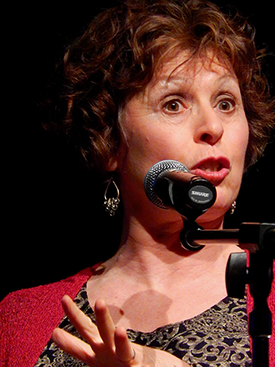
Noa Baum is a storyteller and educator in the Washington D.C. area. (Photo: Tim Livengood)
And with that he pulled out his sword and lifted it up in the air. The crowd gasped, for indeed it was made of wood. Some people fell upon their knees at the miracle they had just witnessed, but the king, watching it all from his balcony, smiled at the wisdom of that man. He came down, and he said to him,
“I am the guest that you have welcomed so generously into your home these last few nights, and now I’d like to ask you to come and be MY guest. Live in the palace by my side. Be my advisor. Teach me how to live as you do, with so much faith and so much joy, day by day.”
And with that, they joined arms and went up the palace steps, singing. “Din-ay-din-ay-din-ay-din-ay! Din-ay-din-ay-din-ay-din-ay-din-ay-din-ay, hey!” (wordless singing)
CURWOOD: (LAUGHS.) Wow, that’s a great, funny story!
BAUM: It is. (LAUGHS.)
CURWOOD: To have faith, maybe you have to be a bit of a trickster at the same time, huh?
BAUM: Absolutely. To have faith does not mean that you have to be blind or stop thinking. It just means that you have to believe that things are possible.
CURWOOD: That’s storyteller Noa Baum with her tale The Wooden Sword. And you can hear more of her stories on our holiday season show next time on Living on Earth.
Related links:
- The Wooden Sword: A Jewish Folktale from Afghanistan
- About storyteller and educator Noa Baum
[MUSIC: Field recording of traditional tune from “Spring Song,” available on YouTube at https://www.youtube.com/watch?v=K25dOx7aYRQ]
Living on Earth is produced by the World Media Foundation and brought to you with support from the University of Massachusetts Boston, in association with its School for the Environment, developing the next generation of environmental leaders. Our crew includes Naomi Arenberg, Bobby Bascomb, Emmett Fitzgerald, Lauren Hinkel, Helen Palmer, Adelaide Chen, Jenni Doering, John Duff, Amber Rodriguez, and Jennifer Marquis. Tom Tiger engineered our show, with help from Jeff Wade, Jake Rego and Noel Flatt. Alison Lirish Dean composed our themes. You can find us anytime at LOE.org - and like us, please, on our Facebook page - it’s PRI’s Living on Earth. And we tweet from @LivingOnEarth. I'm Steve Curwood. Thanks for listening.
ANNOUNCER1: Funding for Living On Earth comes from the Grantham Foundation for the protection of the environment, supporting strategic communication and collaboration in solving the world’s most pressing environmental problems. Support also comes from the Kendeda Fund and Trinity University Press, publisher of "Moral Ground: Ethical Action for a Planet in Peril". Eighty visionaries who agree with Pope Francis climate change is a moral issue for each of us. tupress.org. And Gilman Ordway for coverage of conservation and environmental change.
ANNOUNCER2: PRI. Public Radio International
Living on Earth wants to hear from you!
Living on Earth
62 Calef Highway, Suite 212
Lee, NH 03861
Telephone: 617-287-4121
E-mail: comments@loe.org
Newsletter [Click here]
Donate to Living on Earth!
Living on Earth is an independent media program and relies entirely on contributions from listeners and institutions supporting public service. Please donate now to preserve an independent environmental voice.
NewsletterLiving on Earth offers a weekly delivery of the show's rundown to your mailbox. Sign up for our newsletter today!
 Sailors For The Sea: Be the change you want to sea.
Sailors For The Sea: Be the change you want to sea.
 The Grantham Foundation for the Protection of the Environment: Committed to protecting and improving the health of the global environment.
The Grantham Foundation for the Protection of the Environment: Committed to protecting and improving the health of the global environment.
 Contribute to Living on Earth and receive, as our gift to you, an archival print of one of Mark Seth Lender's extraordinary wildlife photographs. Follow the link to see Mark's current collection of photographs.
Contribute to Living on Earth and receive, as our gift to you, an archival print of one of Mark Seth Lender's extraordinary wildlife photographs. Follow the link to see Mark's current collection of photographs.
 Buy a signed copy of Mark Seth Lender's book Smeagull the Seagull & support Living on Earth
Buy a signed copy of Mark Seth Lender's book Smeagull the Seagull & support Living on Earth

